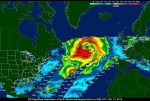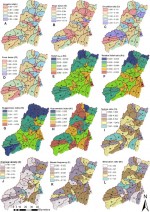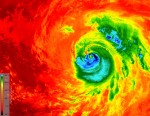
Tuesday, December 6th, 2016
Every northern fall and winter, cooling ocean and air temperatures cause the floating cap of Arctic sea ice to grow from its annual minimum extent toward a maximum between February and April. So far in 2016, however, the Arctic Ocean and neighboring seas have been slow to freeze, setting both daily and monthly record lows.

Tuesday, November 29th, 2016
On Sept. 21, 2014, NASA scientists and engineers launched RapidScat toward the orbiting International Space Station, 250 miles above Earth’s surface, with a few objectives in mind: improve weather forecasting on Earth, provide cross-calibration for all international satellites that monitor ocean winds, and improve estimates of how ocean winds change throughout the day. Following the

Monday, November 14th, 2016
Researchers from UT Dallas and other universities developed geospatial science methods to help the Egyptian government determine how to avoid flooding in a coastal mountain region. The government wants to develop the area for tourism, but flash flooding and associated hazards have hampered efforts, according to Dr. May Yuan, Ashbel Smith professor of GIS. “We

Monday, October 24th, 2016
A new study using NASA satellite data finds that tide gauges—the longest and highest-quality records of historical ocean water levels—may have underestimated the amount of global average sea-level rise that occurred during the 20th century. A research team led by Philip Thompson, associate director of the University of Hawaii Sea Level Center in the School

Tuesday, October 18th, 2016
Throughout the developing world, access to lifesaving and critical health products is hampered by “the last-mile problem”: the inability to deliver needed medicine from a city to rural or remote locations due to lack of adequate transportation, communication and supply chain infrastructure. To lessen this problem, the Rwandan government will begin using drones to make

Tuesday, October 11th, 2016
As Hurricane Matthew developed into a Category 4 hurricane that pummeled the Caribbean and southeastern United States, killing more than 1,000 people, disrupting electricity and other utilities to hundreds of thousands, and causing billions of dollars in economic damage, many of the world’s satellites and sensors were tuned to the storm, and recorded its path

Tuesday, October 4th, 2016
Teledyne Optech is pleased to announce it has partnered with The Ocean Cleanup in their Aerial Expedition research mission, where the Optech CZMIL (Coastal Zone Mapping and Imaging Lidar) successfully carried out the first in a series of low-speed, low-altitude survey flights across the Great Pacific Garbage Patch. Every year, about eight million tons of